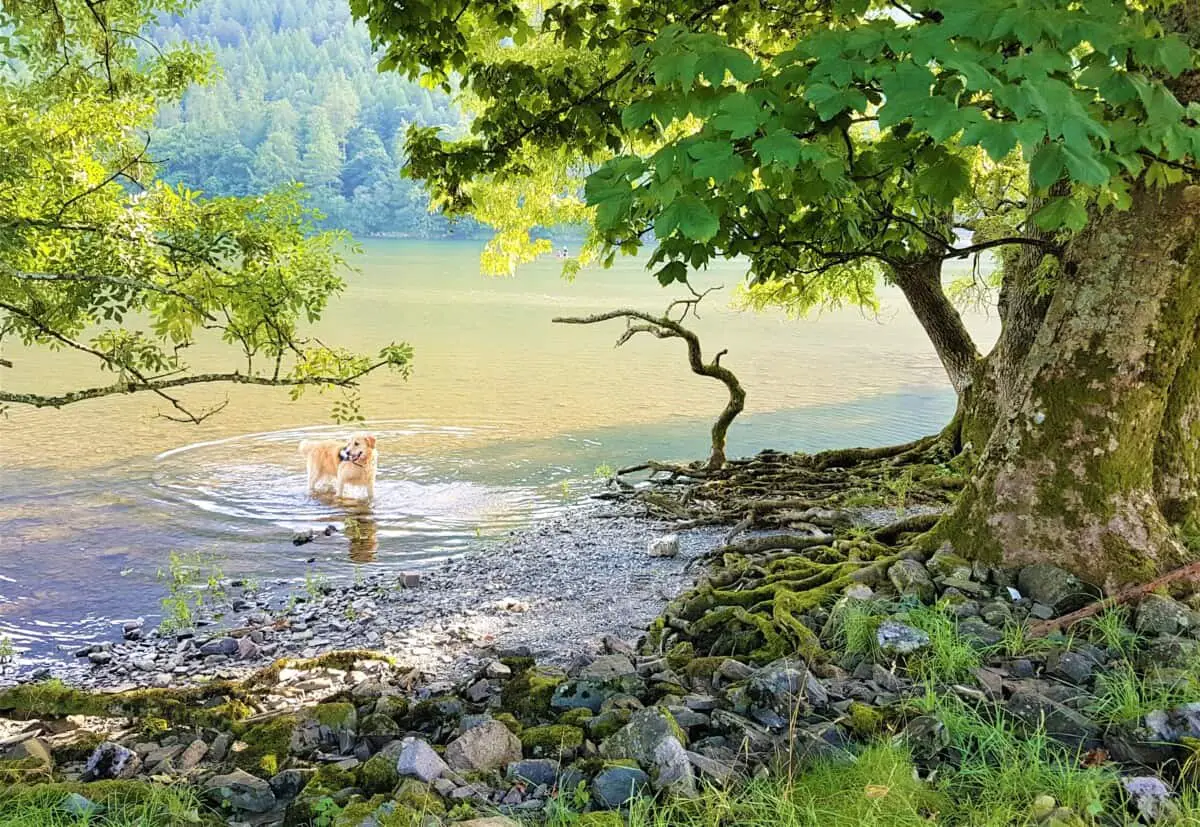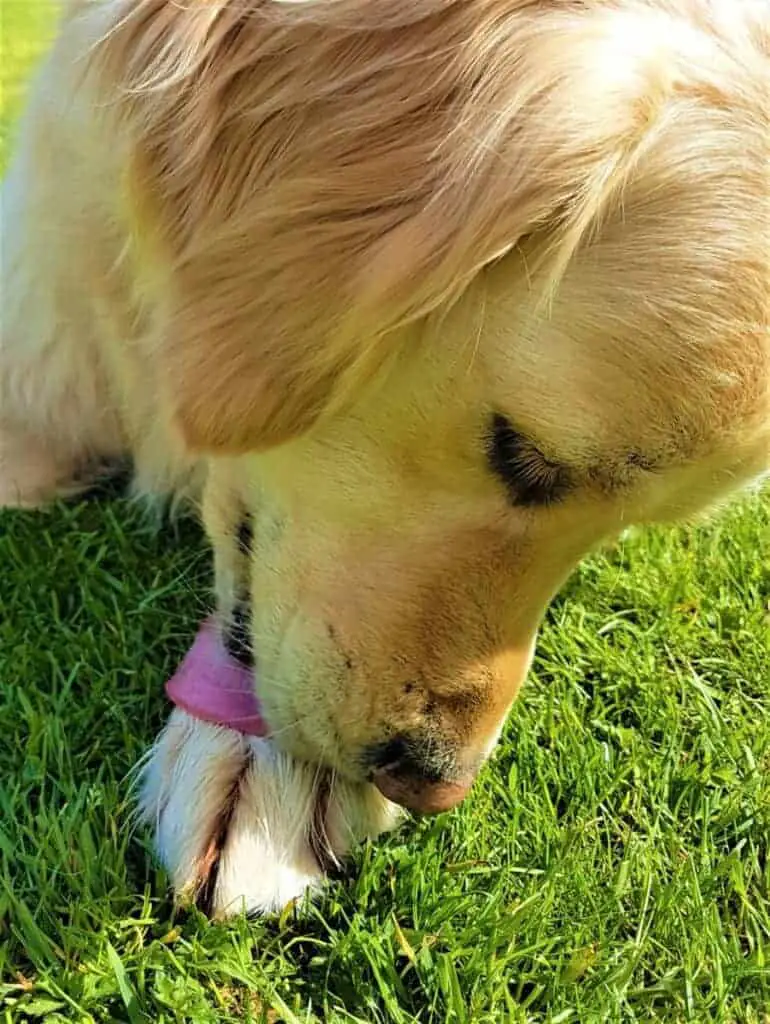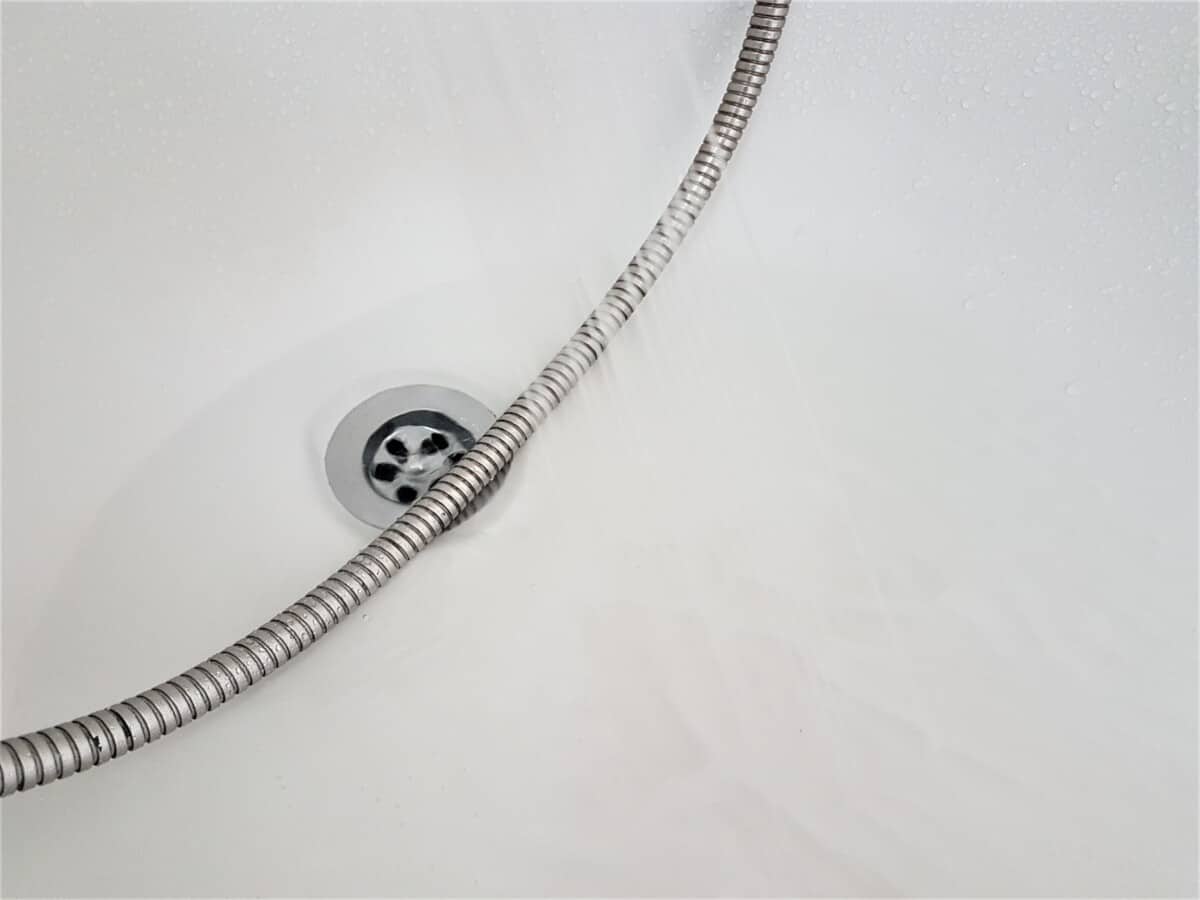Every owner knows that most dogs will love the water, whether it is on a lake or splashing about in the sea. Unfortunately, it often seems that when the time comes to washing your dog they are extremely reluctant, so why do dogs hate baths.
The most common reason dogs hate baths is because they do not feel in control. Being sprayed with jets of water in an enclosed space makes a dog feel out of control and differs completely from the experience of running in and out of a river.
To help understand in more detail why dogs hate baths, it’s important to assess all the details surrounding dogs and their relationship with water. This article will help give more understanding as well as how to negotiate bath time with your own dog.
Contents
Why Do Dogs Hate Baths
Firstly it’s important to understand that every dog is different and when discussing behaviors, fears, or dislikes, your own dog may be slightly different from the average. This article highlights some of the reasons why your dog may dislike bath time.
Fear Of Enclosed Spaces
Often people are surprised that dogs can suffer from different levels of claustrophobia. It took a while to figure out that my own dog had a small fear of enclosed spaces. The fear was not as obvious as you may think, in fact, my Cooper appeared quiet and still when put in a crate, or the car, or the bath, or anywhere really where he was enclosed. What made me realize eventually was when we were playing. Trapped in a corner he suddenly went quiet, with a similar demeanor as in the other enclosed locations.
Of course, my dog’s case is not near the level of some dog’s fear. Cooper will just stand or sit there until the experience is over. The most obvious behavior you will see from a dog with this fear is an attempt to flee, or even become aggressive.
The only way to deal with a dog that has some form of claustrophobia is to slowly change its opinion on certain places. Of course, an unfamiliar location that is enclosed will always have a negative effect. Despite this, you can always attempt to change their mind regarding locations they often visit, such as the car or the bath. As an example, the car has become a negative experience for my dog and so I have slowly brought about positive reinforcement. This has been done by making the area of the car he stays in for journeys, as comfortable as possible, this involves plenty of blankets and toys. See what you can do to make those areas your dog hates more bearable for them.
Fear Of Water
Although fear of water is fairly uncommon when it comes to dogs, let’s face it, you don’t blink an eye when you see a dog running into the river or the sea. Despite this, it can certainly be an issue for some dogs.
Aspects that can determine if your dog has a fear of water are listed below:
Breed – The breed of your dog can determine if they enjoy water or even if they are capable of confidently swimming. Having a flat-nosed dog such as a pug or Boston terrier may lead to your dog not liking the water, instinctively they will realize that their biological makeup does not equip them to be near the water.
Height – The height of your dog is another physical trait that may hinder them when it comes to the water and leading them to hate baths. Despite shorter dogs struggling more in rougher water some small dogs love to swim. Take the Cavalier King Charles Spaniel for instance, despite being small they love to swim, the spaniel part of their DNA makes them want t to be in the water.
Coat – Again another biological trait that helps dogs adapt to water and enjoy baths more is not being cold. If your dog begins to liken water to be cold and they are shorter-haired dogs then they may choose to hate all water including baths. Golden retrievers tend to love water as their thick double coat protects them against cold water, in addition, they are bred to retrieve game over longer rural distances.
Past experience – This has a big impact on how your dog will react to water. If your dog has a bad experience with any sort of water they may begin to fear it. The early years of a dog’s life leave a lasting impression on its character, dogs have a reactive memory and so will shy away from certain things due to past experience. Remember your dog doesn’t know that the bath is less harmful than the sea they will just associate the water and react to this alone.

Fear of Cleaning Products
It’s unlikely that owners won’t use some sort of dog cleaning product on their pooch, especially if it involves a needed wash. Cleaning products will usually be used because your dog is smelly, its great to wash dirt out but usually, any distinguishable dirt will soon make its way back onto your dog.
Dogs can become scared of having a bath because of cleaning products such as dog shampoo. Your dog’s nose is extremely powerful and can amplify even the faintest of smells. Take a look at our article “Understanding Your Dogs Nose” for some extra knowledge on how dogs use scent. Dog shampoo brands tend to make their shampoos dog friendly with lots of consumer testing done to establish whether a dog likes the smell. However, you must keep in mind that all dogs are different, and some smell that dogs love some dogs can’t stand.
In most cases it’s not the shampoo itself that is scaring your dog, it’s the reminder that it’s bath time. This is why testing whether your dog likes the smell of their shampoo won’t usually work as they will shy away because they think they are having a bath. From personal experience, I can show my dog the shampoo we use and he will run a mile, even if we were out on a walk, with no bathtubs insight.
How To Give a Dog a Bath That Hates Baths
Here comes the part that all those owners with dogs that hate baths want to read. In this section, I give some tips on how to bathe your dog despite their dislike for them.
Preparation
I want to talk about preparation first as this can be the one thing most owners forget. If you are prepared for your dog’s bath then there is less stress on your part and fewer distractions to allow your dog to escape.
Items you should have on hand before bathing your dog are doggy shampoo and lathering gloves, these gloves help rub the shampoo into your dog’s fur effectively.
A clear area to work cannot be understated, the last thing you need is bottles and other items being thrown onto the floor by your wriggly pooch. This leads me to another very handy tip. Bathtubs are slippy and you will most certainly find your dog is unstable in the bathtub. This can be even worse for larger dogs who are trying to balance. The easiest fix for this is to use a rubber antislip mat, nothing fancy just the same as you would use.
The final items to have prepared are enough towels to both dry your pooch and cover the bathroom floor. Remember that dogs love to shake and their fur tends to absorb lots of water, even with shorthaired dogs.
One final tip on being prepared is to not show your dog any of these items before you get them into the bathroom. Subtlety is important as your dog will most likely remember these items from the last time they had a bath.

How To Get Your Dog In The Bath
Unsurprisingly this is the most difficult thing we are going to look at and in most cases, it’s the part most owners struggle with when bathing an unwilling dog.
Positive encouragement is important in everything you do with your dog. Instead of getting frustrated that your dog doesn’t want to go near the bathroom, try doing some pre-bath time association. For example, if your bathroom is located upstairs, or in a certain area of the house, play with your dog in these areas beforehand.
Now I’m not talking right before you give them a bath, but whenever you see an opportunity to generate a positive association with this area of the house. By doing this your dog won’t instantly think the only reason they are being ushered to this part of the house is that they are having a bath. Admittedly my dog still has his suspicions when I want to play upstairs but the temptation is too much and believes me this is much easier than carrying a 37 kg golden retriever up the stairs.
How To Make A Dog Stay In The Bath
Getting your dog to stay in the bath can be a difficult task too. Some dogs will be so desperate to leave they will leap over the tub to their escape. Encouragement is always the first port of call, make your dog want to stay in the bath. If your dog is a foody have some treats on hand, or better yet spread some delicious peanut butter on the bathroom tiles or stick a treat mat to the wall. Obviously, try to keep the peanut butter dry but hopefully, this will encourage your dog to stay put.
If your dog is not much of a foody or simply the fear of being in the bath is not worth the treats then positioning yourself correctly can help. Generally, if your dog feels there is no easy way to escape then they usually won’t attempt to. Using a clothes horse to hang some towels on can create the illusion that there is no free space to run into, of course at the same time make sure there is enough room for you to work.
If you have ever been to a dog groomer you will notice that they have an attachment for a lead on the bathtub. This is generally unfeasible at home but if at all possible it could be a good idea, especially if your dog struggles a lot. Its also worth noting that commands such as stay can be used in this situation, as dogs love to please their owners and if your dog is well versed in his commands they may become less agitated.
Outdoor Dog Bath
One last tip to end this section will be around outdoor doggy baths. If you are able to purchase or even build an outdoor dog bath, you may make your life much easier when it comes to washing your dog.
For example, if you have just got back from a walk they can climb straight in. In addition to this, they may also feel less enclosed and more comfortable. the only you may have is getting some warm water to use when bathing your dog. Although most dogs don’t mind light cold water, dirt tends to come off easier with warm water.
Why Do Dogs Go Crazy After a Bath
Dogs go crazy after a bath because they are excited and can have different reactions depending on their character and whether they enjoy baths or not. Some dogs will run around excited that they are wet, other dogs may start running around with the shear release of vent up energy. Frustration is a big part of why dogs go crazy after anything, our article on “Why Do Dogs Go Crazy After A Walk” explains everything you need to know about FRAPS or what many owners call the zoomies.
Do Dogs Need Baths
Bathing a dog is lots of hard work and often ends with disappointed owners watching their dog roll around in the mud outside, this makes you question whether your dog actually needs a bath. Dogs need a bath to keep their coat and skin healthy. Although natural oils intended for protection, seep from their hair follicles, most dogs’ fur will begin to look matted and become dirty.
Dogs in the wild can sometimes be seen licking one another to ensure they stay clean. As domesticated dogs do not have this privilege it is up to us, their owners to ensure that they keep a healthy clean coat. Smells can also cause us humans a bit of agro, again dogs are domesticated and so living within the home means passing on smells that may be unwanted. Unless you are willing to create a comfortable living space outside for your dog, you will either have to put up with the smell or give them a bath.
Be aware that water can intensify the smell of your dog as it disturbs all these natural oils seeping from the skin, this is the reason why wet dog smell is so repulsive. Check out our article on “Why Does My Dog Smell So Bad After A Walk” for more information on wet smelly dogs.
In addition to washing your dog in the bath whenever you feel the time is right, try washing after their walk. Many owners will find that their dog is at its dirtiest and smelliest straight after a walk. If you can learn to clean your dog after a walk, whether it is a thorough clean or even a rinse, you may limit the number of times you need to bathe your dog. Here are our best tips and tricks on washing your dog straight after a walk, “How To Wash Your Dog After A Walk”.
Providing you do not wash your dog too much, baths are perfectly fine for dogs to have. Overwashing is the culprit of dry skin and faded fur coloring, so be gentle and do not overwash.

Do Dogs Clean Themselves
This leads nicely to whether dogs clean themselves. As highlighted above dogs do require a bath every now and again. But this doesn’t mean you have to bathe them whenever they get a little bit dirty.
Dogs clean themselves by licking. This can be done by themselves or even by other dogs in the pack. Because a dog’s saliva has antibacterial properties, cleaning itself becomes an important process for tending to wounds. Check out this article from the AKC on whether dogs should lick their wounds.
Most of the licking that a dog does is for hygiene reasons, this includes tending to wounds, brushing their fur, keeping it dirt-free and unbelievably dry themselves. If you leave your dog alone after their walk you will find that they have cleaned themselves without any fuss. Licking can often last for a while, especially if your dog is wet, check out our article on “Why Do Dogs Lick Themselves After A Walk”. We also have a great article on how to dry your dog, here are 5 of the best ways to try your dog. Despite your dog’s saliva having some antibacterial properties, it is still best to bathe them when the time is right, as they all tend to eat what they shouldn’t…who knows where they have been.
Conclusion
So there you have it dogs hate baths mainly because they are not in control. When this is added to any fears or anxieties, bathing your dog becomes almost impossible. hopefully, these tips will help with any future dog bathing activities. If you enjoyed this article check out our other posts on our homepage.

